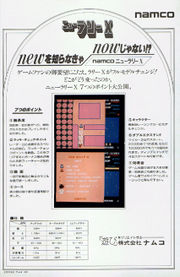Lost In Translation/New Rally-X
| New Rally-X | |
|---|---|
| Manufacturer | Namco |
| Released | 1981 |
| Control Method |
4-way Joystick 1 Button(s) |
| Main CPU | Z80 (@ 3.072 MHz) |
| Sound CPU | Mono Namco (@ 96.000 kHz) Discrete |
| Video Details |
Raster (Horizontal) 288 x 224 pixels 60.61 Hz 32 Palette colours |
| Screens | 1 |
| ROM Info | 12 ROMs 21,600 bytes (21.09 KiB) |
| MAME ID | nrallyx |
About The Game
New Rally-X is an arcade video game where the player drives a car around a maze picking up all of the yellow flags, of which there are 10, before the car's fuel runs out. The game-play has a similar feel to another Namco legend, "Pac-Man"; although in New Rally X's mazes are much larger and, with each maze having only 10 flags to collect, is more sparsely populated than Namco's pill-eating legend.
In-game opponents consist of red enemy cars that try to ram into and destroy the player's car, a problem compounded by the fact that enemy cars are faster than the player's. A smoke screen can be activated which trails behind the player's car and causes any pursuing enemies to crash. Each maze also has rock formations which, if crashed into, will result in the loss of a player car. A radar display to the right hand side of the playing area shows the positions of both the flags and the enemy vehicles.
New Rally X is an update of the 1980 release, "Rally-X". The sequel has slightly different graphics to the original game, and has more forgiving gameplay.
Trivia
Released in February 1981.
While the original "Rally-X" released under a Bally Midway license was a moderate hit in the United States, Bally Midway only distributed this updated version as an upgrade kit for Rally-X cabinets. The game appeared quite frequently in mainland Europe and the United Kingdom, mainly in the form of uncredited bootlegs. It was at least as popular as Rally-X in these regions, if not more so, primarily due to the game's greater playability and abundance of bootleg board stock.
Scoring
- Collecting a flag : 100 points x the flag collected up to a maximum of 1,000 points.
- Special Flag : Doubles points for all flags collected. If collected first, the last flag is worth 2,000 points.
- Lucky Flag : Bonus points x Remaining Fuel.
- End of screen bonus : Points for remaining fuel.
Tips and tricks
Easter Egg
- Enter service mode.
- Keep B1 pressed and enter the following sequence : Up(x2), Down(x7), Right, Left(x6).
- '(c) NAMCO LTD. 1980' will be added at the bottom of the screen.
Series
- Rally-X (1980)
- New Rally-X (1981)
Staff
- Music By
- Nobuyuki Ohnogi
Cabinet and Artwork
Ports
- Consoles
- Sony PlayStation (1995, "Namco Museum Vol.1")
- Sony PSP (2005, "Ridge Racers")
- Sony PSP (2005, "Namco Museum Battle Collection")
- Computers
- PC [MS Windows, CD-ROM] (1997, Namco History Vol.2")
- Others
- Arcade (1996, "Namco Classics Collection Vol.2")
- Ms. Pac-Man TV Game Wireless Version (2005 - Jakk's Pacific)
Soundtrack Releases
| Album Name | Catalogue No. | Released | Publisher | Comments |
|---|---|---|---|---|
| Video Game Music | YLR-20003[1] | 1984-04-25 | Alfa | Vinyl version. |
| The Best of Video Game Music | 32XA-66[2] | 1986-04-25 | Alfa | CD version. |
| Video Game Music | YLC-20003[3] | 1984-04-25 | Alfa | Cassette version. |
| Video Game Music | SCDC-00003[4] | 2001-03-23 | Scitron Digital Content, Inc. | CD version. |
| 765 MEGA-MIX | APCG-4014[5] | 1991-07-21 | APOLLON | CD version. |
| NAMCO Classic Collection Techno Maniax | PCCG-00440[6] | 1998-02-18 | Pony Canyon, Inc. | CD version. |
| Namco Best Hit Parade! | VDRY-25023[7] | 1989-11-21 | Victor Entertainment Inc. | CD version. |
| Namco Best Hit Parade! | VICL-5038[8] | 1990-11-07 | Victor Entertainment Inc. | CD version. |
| Famison 8BIT - iDOLM@STER 04 Makoto Kikuchi / Yukiho Hagiwara | FVCG-1014[9] | 2008-05-28 | 5bp. Records | CD version. |
References
- ↑ Video Game Music (Vinyl) at the VGMdb
- ↑ The Best of Video Game Music (CD) at the VGMdb
- ↑ Video Game Music (Cassette) at the VGMdb
- ↑ Video Game Music (CD) at the VGMdb
- ↑ 765 MEGA-MIX (CD) at the VGMdb
- ↑ NAMCO Classic Collection Techno Maniax (CD) at the VGMdb
- ↑ Namco Best Hit Parade! (CD) at the VGMdb
- ↑ Namco Best Hit Parade! (CD) at the VGMdb
- ↑ Famison 8BIT - iDOLM@STER 04 Makoto Kikuchi / Yukiho Hagiwara (CD) at the VGMdb



